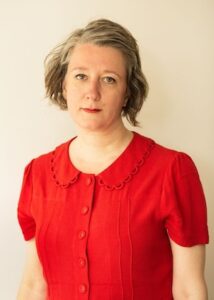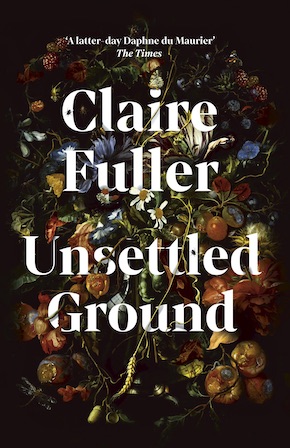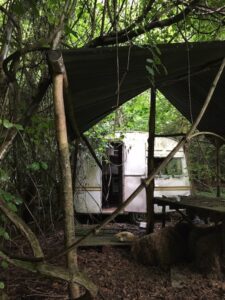Liminal inspiration for Unsettled Ground
by Claire FullerA bookseller who was interviewing me for an event once commented that the one thing that he could see which linked all my novels was that the main characters live in buildings which shouldn’t really be habitable. Unsettled Ground, my fourth novel, is no exception.
I have always been fascinated by buildings that humans once used or inhabited and have now left. A couple of years ago I was accepted onto a writers’ residency with a difference. This wasn’t a residency in a library or museum, neither was it a retreat in some beautiful country estate in the woods of New England; instead The Liminal Residency takes a small group of writers to a neglected and unusual place and facilitates writing workshops, collaboration and inspiration. They say on their website (liminalresidency.co.uk) that the residency, “may involve difficulty, dislocation, boredom, intense excitement, loneliness or self-discovery. It is an intentionally uncomfortable and unpredictable experience.” After the residency is finished and the writing is edited, they produce a pamphlet and hold an event where some of the pieces are read to an audience. In the past the Liminal Residency has taken writers to a motorway service station and Heathrow airport. My group went to Alton Towers.
Most people, if they’ve heard of Alton Towers, know it as a theme park with rollercoasters, water rides and haunted houses, but it also has several acres of gardens, which contain many disused buildings and some rather sad corners. It was mostly these that the residency explored, taking inspiration from the less-visited areas. (Although some of us also found inspiration in the screams coming from the rides and the weird sensory-overloaded Alton Towers Hotel.) This experience made me focus even further on the places people have forgotten.
Around the time that I was finishing writing my third novel, Bitter Orange, my son took me to see a caravan he had come across in some woods near to where I live. It was a two-berth caravan, badly vandalised – with its windows smashed and its door hanging off. Inside, a few belongings had been left behind: a heap of bedding, a pair of old shoes, a cassette tape. The place smelled of damp cardboard walls, of rotting fabric and of plastic that the sun has heated too intensely. Outside, the caravan had once been white, but now under the trees it had turned a dirty green, and moss had grown into the rims of the windows. Old spider webs clustered in corners and the trees crowded around it as though trying to look inside. There was an atmosphere too, as though I could sense the people who had once lived there; it was haunted but not by the dead. As a writer I loved it, even though it was a grim and desolate place.
Outside, the caravan had once been white, but now under the trees it had turned a dirty green, and moss had grown into the rims of the windows… the trees crowded around it as though trying to look inside.”
Back at my desk, working through my final edits for Bitter Orange, the caravan kept playing on my mind. It was quite a way from any road, a long way from a village or town, and there had been no track to it through the woods. Who had lived there before it was vandalised? An agricultural worker or someone who had nowhere else to go? What in their life had brought them to this place, and how did they manage? There was no electricity, no running water, no bathroom or toilet. And when they left what turn did their life take then? Did it improve or was there further for them to fall? These are kinds of questions that all my novels start out with. A place, and then very soon after, the person who lived there.
It was Jeanie Seeder who stepped out of a caravan sited on a bit of wasteland just off a main road. Her caravan is not as beaten up as the one I visited and it’s bigger, but she is just as shocked when she first sees it as I was to see the one in the woods.
But I knew that Jeanie’s story didn’t start or end in the caravan. It is for her very much a liminal space: she moves to it, and she moves on from it. In order to work out what would take her there I had to go backwards to discover what happens to her.
At around the same time, my best friend Jill was house-hunting and I went with her on a few occasions – mostly because I’m nosy, although I like dress it up and say it’s because I’m a writer and I’m researching. On one trip we went to what might also be called a liminal place: a thatched cottage which needed a lot of renovation work. The estate agent told us that the owner had died and the house was being sold by her adult children. Inside, it became clear that it had once been two cottages which had been knocked together in a rudimentary way, so that two fireplaces were still at either end, as well as both the original staircases with doors at the bottom to keep out the draughts. The cottage smelled unlived in, and it appeared that the dead woman’s children had taken all the furniture that they could use or sell but had left the things they didn’t want, including dusty packets and tins of food in the kitchen, a chair which had lost most of its rush seating, and some odd china ornaments on a windowsill.
This became Jeanie’s cottage, with its two fireplaces and scullery at the back. And Unsettled Ground starts with Jeanie’s mother Dot in the bed up the left-hand staircase, waking because outside snow is falling and it’s the end of April…
 Claire Fuller was born in Oxfordshire in 1967. She gained a degree in sculpture from Winchester School of Art, but went on to have a long career in marketing and didn’t start writing until she was forty. She has written three previous novels: Our Endless Numbered Days, which won the Desmond Elliott Prize, Swimming Lessons, which was shortlisted for the RSL Encore Award, and Bitter Orange. She has an MA in Creative and Critical Writing from the University of Winchester and lives in Hampshire with her husband. Unsettled Ground, published in hardback, eBook and audio download by Fig Tree/Penguin Digital, is longlisted for the 2021 Women’s Prize for Fiction.
Claire Fuller was born in Oxfordshire in 1967. She gained a degree in sculpture from Winchester School of Art, but went on to have a long career in marketing and didn’t start writing until she was forty. She has written three previous novels: Our Endless Numbered Days, which won the Desmond Elliott Prize, Swimming Lessons, which was shortlisted for the RSL Encore Award, and Bitter Orange. She has an MA in Creative and Critical Writing from the University of Winchester and lives in Hampshire with her husband. Unsettled Ground, published in hardback, eBook and audio download by Fig Tree/Penguin Digital, is longlisted for the 2021 Women’s Prize for Fiction.
Read more
clairefuller.co.uk
writerclairefuller
@ClaireFuller2
Author portrait © Adrian Harvey Photography



